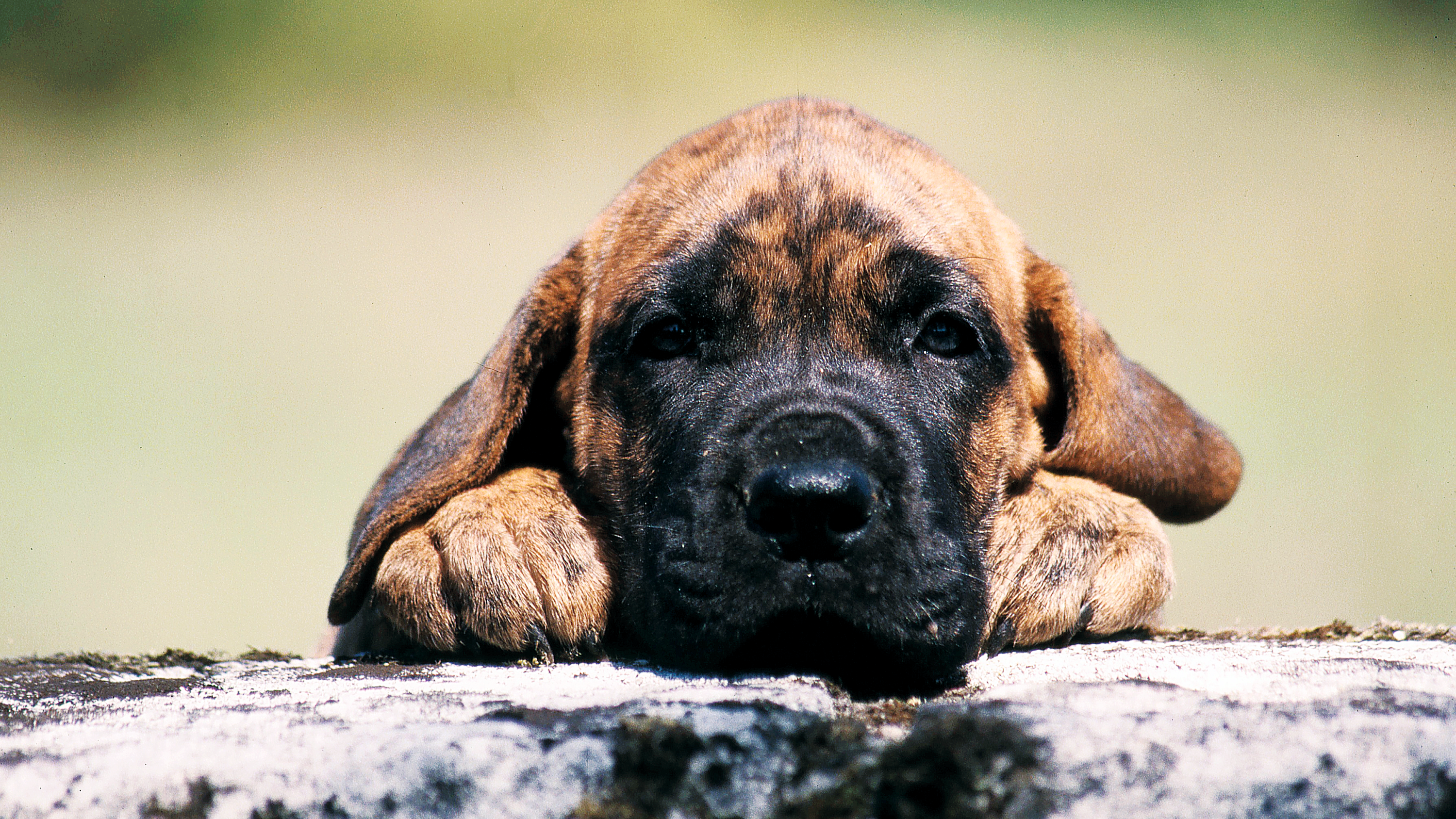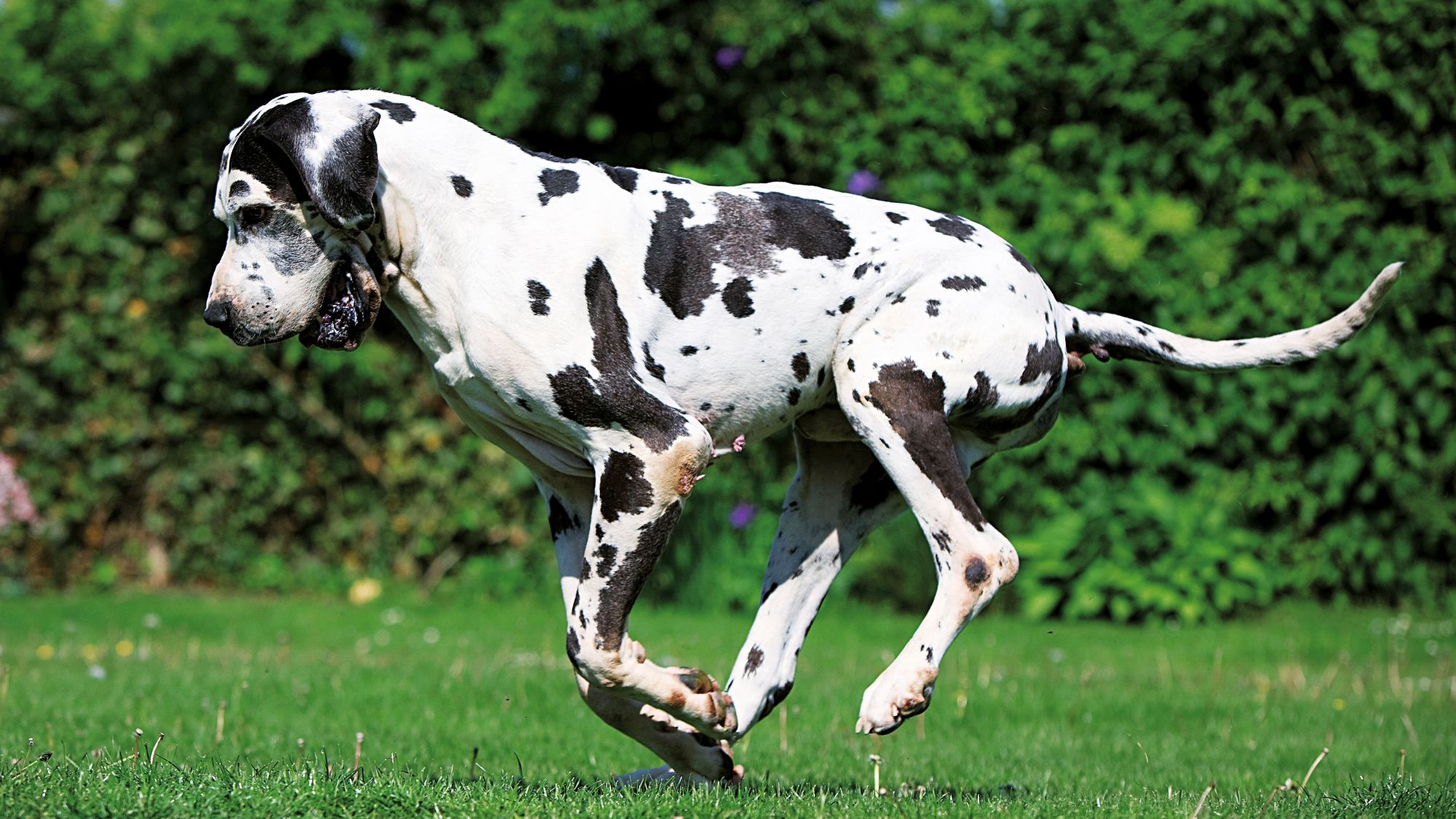Let's talk Great Danes
Official name: Great Dane
Origins: Germany
Drooling tendencies
4 out of 5Shedding Level
3 out of 5Energy level
3 out of 5Compatibility with other pets
5 out of 5Warm weather?
2 out of 5Suited to apartment living
1 out of 5Family pet
3 out of 5Can be left alone
1 out of 5
| Male | Female |
|---|---|
| Height | Height |
| 76 - 81 cm | 71 - 76 cm |
| Weight | Weight |
| 63 - 77 kg | 50 - 63 kg |
| Life Stage | |
|---|---|
| Puppy | Adult |
| 2 to 8 months | 2-5 years |
| Mature | Senior |
| 6-7 years | 8-10 years |
| Baby | Junior |
| Birth to 2 months | 8 month to 2 years |
Drooling tendencies
4 out of 5Shedding Level
3 out of 5Energy level
3 out of 5Compatibility with other pets
5 out of 5Warm weather?
2 out of 5Suited to apartment living
1 out of 5Family pet
3 out of 5Can be left alone
1 out of 5
| Male | Female |
|---|---|
| Height | Height |
| 76 - 81 cm | 71 - 76 cm |
| Weight | Weight |
| 63 - 77 kg | 50 - 63 kg |
| Life Stage | |
|---|---|
| Puppy | Adult |
| 2 to 8 months | 2-5 years |
| Mature | Senior |
| 6-7 years | 8-10 years |
| Baby | Junior |
| Birth to 2 months | 8 month to 2 years |

Get to know the Great Dane
Great Danes are the big friendly giant of dog breeds.
They are handsome hounds with a majestic demeanor, alert expression, and a dense, glossy coat in one of three evocative color combinations: fawn and brindle, black and harlequin, or blue.
Once trained, Great Danes get along well with children and can make lovely family pets. However, they do require a level of commitment greater than what would be required for smaller breeds.
Great Danes need a decent amount of exercise, though, despite their size, they are not the most energetic breed around. Once fully grown, they enjoy a variety of activities —walks, runs, and the chance to potter around in an enclosed space. One thing to keep in mind is that, due to their enormous size, Great Danes have a shorter than average lifespan.
On a day-to-day basis, the only real downside to having a Great Dane as a pet is the slobber. They drool a considerable amount. But these affable, larger-than-life characters more than make up for that with the joy they bring to their human companions.

Two facts about Great Danes
1. Scooby-Doo, Where Are You?
The lovable but cowardly cartoon canine Scooby Doo is thought to be loosely
based on a Great Dane! The breed has had another brush with stardom in the
form of Marmaduke, the super-size star of a comic strip in the 1950s, which
was then transferred to the big screen in 2010.
2. Great (Not) Dane
The Great Dane doesn't originate from Denmark. The large breed's
origins begin in Germany during the late 1800s when a committee of judges
and breeders met in Berlin to classify several similar dogs known by different
names under just one: Deutsche Dogge which translates into English as
German Dog. So the breed became known in English as the Great Dane.
History of the breed
For a breed with such a long history, it’s not surprising that the Great Dane’s origins are not always clear. There are images from Egyptian tombs that suggest Great Danes have existed for thousands of years. Mastiff- and greyhound-like breeds, as well as the extinct German hunting dog, the Bullenbeisser, are thought to feature in the Great Dane’s ancestry.
Great Danes were prized as wild boar hunters as well as guard dogs in Medieval Germany. When the breed first came to the United Kingdom, the dogs were known as German boarhounds.
In the 19th century, several similar varieties were classified together under the new name Deutsche Dogge. How that became Great Dane in English is not clear, but to complicate matters further, it may have been via the translation of a French name given to the breed: Le Grand Danois.
From head to tail
Physical characteristics of Great Danes
1.Head
2.Face
3.Body
4.Coat
5.Tail

Things to look out for
From specific breed traits to a general health overview, here are some interesting facts about your Great Dane
Beware of bloat
Gastric dilatation and volvulus (GDV), more commonly known as bloat, affects many large breeds and can be a problem associated with Great Danes. The signs of bloat to watch for are—bloated abdomen, restlessness, retching, salivation, and whining or abnormal stillness. If your Great Dane is experiencing any of these signs then seek immediate help from a veterinarian. Some owners opt for preventive surgery, which can protect their dogs, at least partially. The procedure, called gastropexy, involves stitching the walls of the stomach in place and should prevent the life-threatening torsion (volvulus) of the stomach, although not the dilatation (bloating). It’s a good start.
Hip problems
Due to their size, the Great Dane can be prone to osteoarticular diseases—or diseases of the bones and joints. In particular, the Great Dane breed can suffer from antebrachial growth deformities. These deformities of the dogs’ forelegs can lead to limited movement and pain. To avoid conditions like these, it’s important to feed Great Danes the correct food from puppyhood and avoid calcium supplements.
Tailored nutrition for Great Danes

When choosing food for a Great Dane, there are many factors to consider: age, lifestyle, activity level, physical condition, and health, including potential sickness or sensitivities. Food provides energy to cover a dog's vital functions, and a complete nutritional formula should contain an adjusted balance of nutrients to avoid any deficiency or excess in their diet, both of which could have health impacts.
As giant-sized breed dogs have a higher risk of a condition called gastric dilatation and volvulus (GDV), where the stomach becomes overstretched and rotated due to excess gas, often caused by overfeeding during a meal, it's recommended to split the daily allowance into three meals for puppies and maintain this routine into their adult years.
The following recommendations are for healthy animals. If your dog has health problems, please consult your veterinarian who may recommend an exclusively veterinary diet.
Strong Immune System
Supports the developments of the puppy's healthy immune system with the inclusion of clinically proven antioxidants, including vitamins E and C.
Intense Growth Stage
This formula helps support your giant breed puppy's unique nutritional needs from 2 to 8 months and helps avoid excess weight gain.
Microbiome Support
Combination of prebiotics & highly digestible proteins to help promote a healthy balance of intestinal bacteria for digestive health.

Like many giant-sized breed dogs, Great Danes are prone to digestive sensitivity. Also, their body weight can place stress on their joints throughout their lifetime. Therefore, the nutritional needs of Great Danes should include high-quality protein and a balanced supply of dietary fiber to promote optimal digestibility. Additionally, the inclusion of glucosamine, chondroitin, and antioxidants are important to help support the health of their bones and joints. A formula enriched with omega-3 fatty acids, such as EPA and DHA, will help maintain healthy skin. An adapted taurine content is also essential to support healthy heart function.
Concentrated Energy
With 80% muscle mass, the energy needs of Great Danes are 50% higher than those of other dogs of the same size. Meanwhile, the short coat provides little insulation against
cold. The Great Dane Adult exclusive, high energy formula is tailored to meet their unique nutritional needs without overloading the stomach.
Digestive Performance<br>A longer colonic transit time as well as a higher colonic permeability in Great Danes leads to more fermentation and the production of poor stool quality. The Great Dane Adult formula supports digestive health while taking into account the Great Dane’s digestive sensitivity, with highly digestible L.I.P.* proteins and a selection of specific fibers to help limit intestinal fermentation while promoting a balanced intestinal flora. *Protein selected for its very high digestibility.<br><br>
Bone & Joint Health
With his imposing stature and very long growth period, the Great Dane’s joints can be placed under stress. The Great Dane Adult formula helps support healthy bones and joints and helps maintain ideal weight. Enriched with EPA and DHA.

Caring for your Great Dane
Grooming, training, and exercise tips
7/7
All about Great Danes
Read more on this topic
Sources
- Veterinary Centers of America https://vcahospitals.com/
- Royal Canin Dog Encyclopaedia. Ed 2010 and 2020
- Banfield Pet Hospital https://www.banfield.com/
- Royal Canin BHN Product Book
- American Kennel Club https://www.akc.org/
Like & share this page